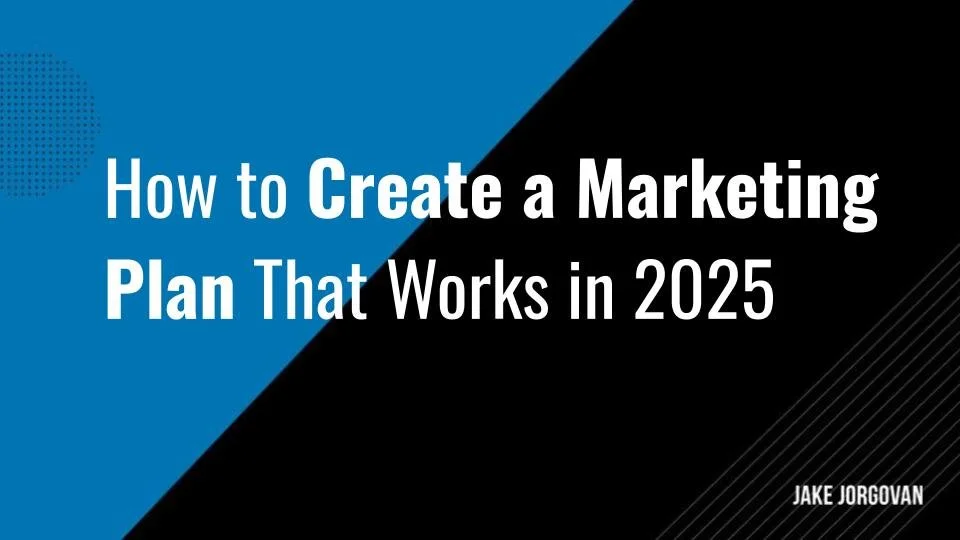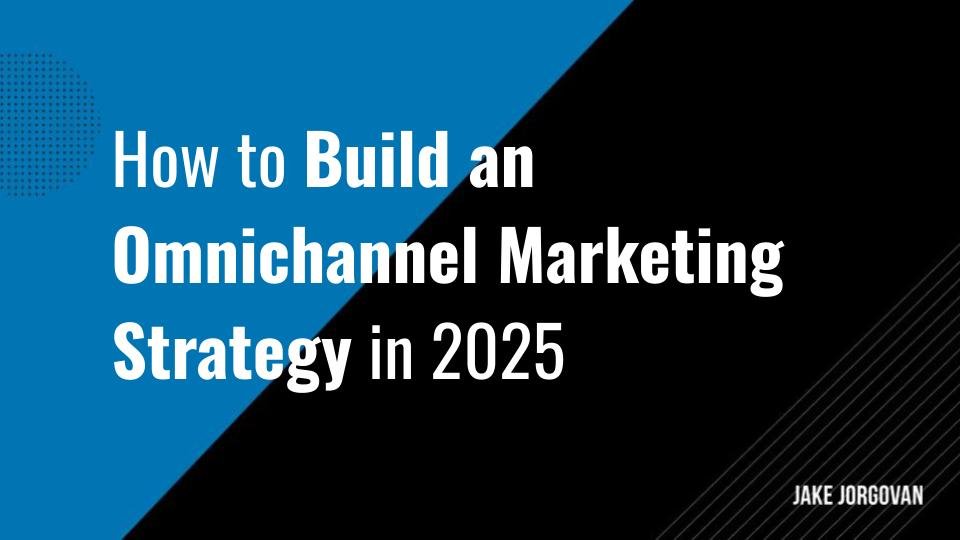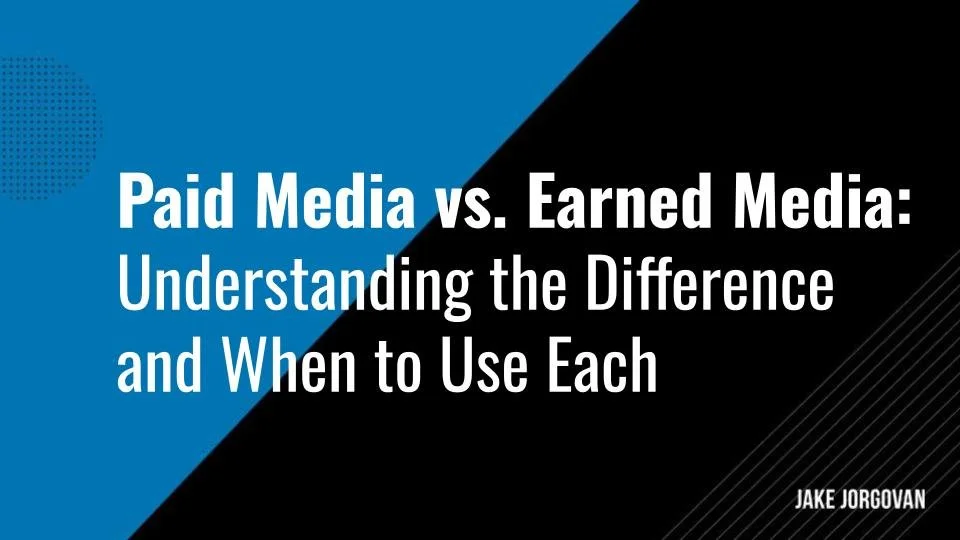How to Build an Omnichannel Marketing Strategy in 2025
Building an omnichannel marketing strategy isn’t easy.
There are too many sources outlining the process theoretically and not enough practical examples.
Let’s fix that.
We’ll walk you through a hands-on approach to create seamless experiences for customers.
And we’ll aim high—let’s say we’re competing with Nike’s omnichannel approach.
Together, we’ll build a system that integrates mobile apps, email marketing, and social media platforms to deliver a consistent experience.
By the end, you’ll know how to create an effective omnichannel strategy that drives customer loyalty and keeps your team focused on results.
Ready to ditch the theory?
Let’s build a strategy that works.
P.S. If you’re serious about building an effective omnichannel strategy, you need the right partners. Check out our list of the Top 35 Growth Marketing Agencies to find experts who can help drive customer engagement, improve conversion rates, and deliver a seamless customer experience across channels.
What Is Omnichannel Marketing?
Omnichannel marketing integrates various marketing channels—such as social media platforms, email campaigns, physical stores, and mobile apps—to provide a unified and consistent customer experience.
"Omnichannel is defined as a multi-channel sales approach that provides the customer with an integrated shopping experience." - Aaron Agius of Hubspot
This approach ensures that customers receive seamless and personalized interactions across all customer touchpoints.
And it works because companies implementing omnichannel strategies have observed a 287% higher purchase rate compared to those using single-channel methods.
Key Components of an Omnichannel Strategy
To build an effective omnichannel strategy, you need key components that align customer touchpoints and deliver a seamless customer experience across every channel:
Customer data platform: Centralizes customer data for actionable insights and unified customer profiles.
Integrated marketing channels: Connects online marketplaces, physical stores, and digital channels for consistent messaging.
Real-time metrics: Tracks customer behavior and preferences across all channels.
Personalized content: Delivers relevant messages based on individual preferences and previous purchases.
Seamless channel access: Allows customers to shift between devices, sales channels, and offline experiences effortlessly.
Let’s say you have a clothing brand.
You’ll use a customer data platform to create a unified profile for people, tracking their browsing habits and purchase history.
Now let’s say a person named Jane browses formal dresses online. The platform registers this and your integrated marketing channels deliver personalized ads on Instagram and recommendations via email.
Real-time metrics track her behavior—she adds a dress to her cart but abandons it. A follow-up email offers a discount, featuring styles tailored to her preferences. Jane completes the purchase on the mobile app and chooses in-store pickup.
At the store, she receives QR-code access to styling tips. Seamless channel integration ensures a smooth, personalized experience, enhancing Jane’s loyalty to your brand.
Customer-Centricity in Omnichannel Marketing
A successful omnichannel approach puts customers at the center, focusing on their preferences, behaviors, and expectations to deliver a unified experience for customers across all channels. That means creating:
Personalized shopping experiences: You deliver tailored marketing messages based on customer preferences and purchase histories.
Seamless cross-device experience: Customers shift between mobile devices, physical stores, and digital channels without friction. Customers receive relevant content on their preferred channels, like SMS messages or email campaigns.
Remember to use real-time customer feedback to refine your omnichannel efforts.
Why Do You Need an Omnichannel Framework?
Implementing an omnichannel framework is a great way for businesses to increase customer satisfaction and retention.
In fact, companies with solid omnichannel strategies retain 89% of their customers, compared to 33% for those with weak strategies.
Additionally, omnichannel customers shop 1.7 times more than single-channel shoppers.
Basically, this integrated approach ensures consistent customer interactions across all marketing channels. This leads to higher conversion rates and increased customer loyalty in the long run.
Omnichannel vs Multichannel Marketing
The difference between omnichannel marketing and a multichannel approach lies in integration and customer experience. Omnichannel marketing places the customer at the heart of its approach, whereas multichannel marketing is product-centric.
Here’s a clear breakdown of the consequences:
| Aspect | Omnichannel Marketing | Multichannel Marketing |
|---|---|---|
| Customer Experience | Unified, seamless user experience across channels | Individual channels operate independently |
| Integration | Connects all marketing channels and touchpoints | Limited integration across platforms |
| Personalization | Delivers personalized content in real time | Focuses on marketing messages by channel |
| Customer Engagement | Stronger customer interactions and loyalty | Fragmented customer engagement |
| Insights | Combines customer data for actionable insights | Isolated data across individual channels |
How to Build an Omnichannel Marketing Strategy Example
Let’s imagine a sportswear company called Surge aiming to outperform Nike.
Let’s follow these steps together to see how Surge could build a successful omnichannel strategy:
1. Understand Your Audience
Understanding your audience is the cornerstone of an effective omnichannel marketing strategy.
And all market research points that the majority of customers use multiple channels for shopping. In fact, 73% of consumers prefer shopping like this.
Analyzing customer demographics, behaviors, and preferences is also essential, especially considering that omnichannel customers have a 30% higher lifetime value compared to single-channel shoppers.
“The most important thing to remember is you must know your audience.” - Lewis Howes, New York Times Bestselling author
Pro tip: Use data analytics and CRM systems to create unified customer profiles. These profiles facilitate personalized experiences that drive engagement and loyalty.
Surge Case Study
For Surge, we start by analyzing customer data from our CRM system and analytics tools, such as Google Analytics.
We segment audiences based on purchase histories and preferences, focusing on mobile device users and social media platforms.
By mapping customer behavior, we identify gaps in customer touchpoints to create personalized offers that outperform Nike’s engagement.
For example, we notice that many customers browse workout gear on mobile devices but fail to complete purchases. To address this, let’s create some personalized offers, like exclusive mobile-only discounts and tailored product bundles that complement previously viewed items.
For customers who frequently engage on social media, let’s introduce interactive Instagram polls to gather feedback and promote limited-time offers based on their preferences.
2. Map the Customer Journey
Mapping the customer journey involves pinpointing all touchpoints where customers interact with your brand.
And you’ll have a lot of them.
Today's consumers engage with nearly six touchpoints before purchasing, with 50% regularly using more than four. Besides, omnichannel customers spend 4% more in-store and 10% more online than single-channel customers.
Analyzing these touchpoints lets you spot where customers face challenges or disengage.
For instance, a study found that 70% of online shoppers abandon their carts, often due to friction in the purchasing process.
Recognizing these pain points allows you to streamline experiences, enhance satisfaction, and boost conversion rates as a result.
Surge Case Study
To outperform Nike, we map the customer journey by identifying every touchpoint where Surge interacts with athletes—from social ads to in-store displays, email campaigns, and post-purchase follow-ups.
We analyze how they discover, evaluate, and buy sportswear, addressing pain points like sizing issues or delivery delays.
To address these issues, we introduce size calculators on product pages and improve delivery tracking transparency.
As you can see, each such new opportunity we uncover strengthens engagement, leading to deeper brand loyalty.
3. Define Clear Objectives and KPIs
To create an omnichannel marketing strategy, set SMART goals: specific, measurable, attainable, relevant, and time-bound.
Align these objectives with your business goals to ensure cohesion.
For instance, aiming to boost customer retention by 15% over the next quarter is both specific and time-bound.
Establishing KPIs such as customer engagement rates, conversion rates, and customer satisfaction scores enables precise tracking of progress. Here are some KPIs to track:
Surge Case Study
For Surge, we’ll set a SMART goal to increase our market share by 5% in 12 months, focusing on Gen Z.
KPIs will include a 15% boost in online engagement and a 10% increase in direct sales.
By targeting underserved niches, we can outpace Nike in audience connection and loyalty.
4. Integrate Marketing Channels
Integrating marketing channels requires aligning your online and offline efforts for seamless customer experiences.
A good first step it to use consistent branding and messaging across social media, email, mobile apps, and physical stores to reinforce trust. Coordinate promotions across these platforms to ensure customers encounter cohesive offers regardless of their preferred channel.
For example, a social media ad can direct users to an in-store exclusive offer, while email campaigns highlight app-specific discounts. Sync your data to track customer interactions and personalize follow-ups.
Surge Case Study
We can outpace Nike by integrating channels to create a seamless Surge experience.
Imagine launching a social media campaign driving users to our app for exclusive training content, with in-store QR codes unlocking personalized discounts.
Emails can highlight these offers, while app notifications keep customers engaged and coming back.
And of course, we can create SEO content to promote our calculators – which are already lead magnets for editorial links.
5. Personalize Customer Interactions
Personalizing customer interactions is a key component of an effective omnichannel marketing strategy.
Leveraging customer data to personalize your messages and offers, and you’ll see a significant surge in engagement; in fact, 90% of consumers find personalized content appealing. Besides, personalized emails have six times higher transaction rates.
Timely, relevant communications are also important. They’ll improve customer experience and create loyalty. This will help you solve a massive issue, as 71% of consumers express frustration with impersonal interactions.
Surge Case Study
At Surge, we outperform Nike by tailoring every interaction.
Using purchase data, we send personalized offers—like 20% off running shoes to marathoners.
Dynamic product recommendations guide users to the gear they actually need.
Timely emails about weather-specific apparel will also make sure we’re relevant, creating a loyalty-driven experience that keeps us ahead in customer preference.
6. Leverage Technology and Tools
Adopting marketing automation platforms streamlines campaigns, enhancing efficiency. As things stand today, 76% of companies currently utilize automation, with an additional 26% planning future adoption.
One automation we advise you to implement is customer data platforms (CDPs). A good CDP consolidates data, enabling personalized interactions.
You can also implement AI and machine learning for predictive analytics. This helps you anticipate customer behavior and optimize your engagement strategies based on it.
For instance, AI-driven marketing campaigns have led to double-digit increases in consumer engagement, resulting in higher purchase rates.
Surge Case Study
To outperform Nike, we’ll adopt tools like HubSpot for marketing automation, integrating campaigns across email and social.
Using Segment as our CDP, we’ll unify customer data for tailored experiences.
For predictive insights, Google Analytics 4 and Salesforce Einstein AI will help us forecast demand trends, enabling smarter inventory and marketing decisions.
Here’s what we find:
Segment highlights key customer segments, such as young athletes frequently browsing performance gear, allowing us to create targeted social ads. Google Analytics 4 identifies high-traffic periods on our website, suggesting optimal times for flash sales and promotions.
Meanwhile, Salesforce Einstein AI predicts an upcoming spike in demand for moisture-wicking apparel based on seasonal trends. This lets us adjust our inventory and ensure some highly relevant marketing campaigns.
7. Ensure Organizational Alignment
To ensure organizational alignment in your omnichannel marketing strategy, you must create alignment between departments.
Departments must collaborate directly to unify messaging and customer interactions. So. train staff to deliver consistent, high-quality messages across channels.
You should also define clear roles and responsibilities for every team involved in the strategy, ensuring they align with shared goals.
Of course, you need to update internal processes to support seamless communication and execution.
Surge Case Study
At Surge, let’s integrate tools that let teams share customer insights in real time.
This alignment builds a cohesive framework, where every interaction reinforces the omnichannel experience and reflects a unified organizational effort.
For example, we ensure alignment by integrating Slack and Asana for seamless collaboration between design, marketing, and sales teams.
Let’s also train staff to deliver unified messaging on Instagram, TikTok, and our Shopify store.
Sharing real-time customer insights via HubSpot helps us outperform Nike by staying agile and consistently engaging customers.
8. Monitor, Measure, and Optimize
To monitor, measure, and optimize your omnichannel strategy, set up real-time tracking for each channel using tools like Google Analytics and Mixpanel.
Analyze data to uncover trends in customer behavior, such as channel preferences or drop-off points in the purchase journey.
Use this data to refine touchpoints and adjust messaging on underperforming platforms.
For example, if Instagram ads outperform email campaigns in engagement, shift resources to amplify impact.
You should also establish KPIs that align with omnichannel objectives and conduct regular reviews to ensure alignment with evolving customer needs.
Remember: Optimization is an ongoing process that ensures your strategy remains competitive and effective.
Surge Case Study
At Surge, we track performance across Instagram, TikTok, and our Shopify store using Google Analytics and Meta Business Suite.
By analyzing customer data, we discovered higher engagement on TikTok but lower conversions.
We can now optimize by introducing exclusive TikTok promotions and simplified checkout flows on Shopify. This tactic helps us outshine Nike in user engagement.
Omnichannel Marketing Examples
Surge is a great example, but leading brands have also implemented sophisticated omnichannel marketing strategies to create seamless customer experiences.
Let’s see what they came up with.
1. Tesla's omnichannel strategy
Tesla uses a direct-to-consumer model. It sells vehicles directly through its online platform and company-owned stores, eliminating traditional dealerships. This approach ensures consistent customer experiences and direct engagement.
Its integrated technology is also solid. Tesla's vehicles receive over-the-air software updates, enhancing functionality post-purchase. This integration keeps customers connected to the brand and fosters ongoing engagement.
Takeaway: A seamless blend of online and offline channels, coupled with continuous product enhancement, can strengthen customer relationships and loyalty.
2. Zara's omnichannel strategy
One of the first advantages here is rapid inventory turnover. Zara introduces new designs frequently, encouraging customers to visit stores and online platforms regularly to discover the latest offerings.
Besides, Zara's integrated inventory allows customers to check product availability across channels, facilitating seamless shopping experiences.
Takeaway: Synchronizing inventory and offering frequent product updates can drive customer engagement across multiple channels.
3. Louis Vuitton's omnichannel strategy
Louis Vuitton is great at exclusive digital content. The brand provides online access to exclusive collections and virtual experiences, enhancing its luxury appeal.
Plus, its collaborations with global ambassadors amplify brand presence across digital and physical platforms, attracting diverse audiences.
Takeaway: Leveraging exclusive content and strategic partnerships can elevate brand perception and engage customers across various channels.
4. Netflix's omnichannel strategy
Netflix utilizes user data to offer tailored content suggestions. These personalized recommendations increase user engagement across devices.
Cross-platform accessibility is also good. Subscribers can access content seamlessly on multiple devices, which ensures a consistent viewing experience.
Takeaway: Personalization and cross-platform accessibility can significantly enhance user satisfaction and engagement.
Omni-Channel Marketing Plan Template
Here’s a comprehensive omni-channel marketing plan template for our sportswear company, Surge. Click the PDF link below to access the file. You’re welcome to copy, paste, and customize it to suit your needs.
Start Omnichannel Marketing: Build Strategies That Drive ROI
Building an omnichannel marketing strategy requires actionable steps tailored for customer engagement across diverse platforms.
Recognizing the potential of a unified approach, where every channel seamlessly interacts, can dramatically enhance customer experiences and increase loyalty.
So, shift to a customer-centric strategy, focusing on personalized interactions that cater to individual preferences and behaviors across all touchpoints.
Make sure every element of your strategy works to deliver consistent, engaging, and rewarding experiences for your customers.
Your strategy must evolve with your audience, continuously adapting to their needs to stay competitive.
P.S. If you're ready to take your omnichannel marketing strategy to the next level, check out our Top 30 Full-Service Marketing Agencies. These experts can help you implement seamless, customer-focused campaigns that drive engagement and results across all channels.
Frequently Asked Questions
What are the 4 C's of omnichannel?
The 4 C's of omnichannel are customer experience, context, content, and collaboration. Customer experience focuses on consistency and satisfaction. Context ensures messaging fits the customer’s situation, improving relevance. Content delivers value tailored to preferences. Collaboration integrates teams and tools to align strategies and maintain fluid execution.
What are the 4 pillars of omnichannel?
Visibility, measurement, personalization, and optimization are the 4 pillars of omnichannel success. Visibility means real-time tracking across channels. Measurement entails evaluating performance with actionable data. Personalization is about improving engagement through tailored messaging. Optimization refines each channel for better alignment with customer expectations.
What is the role of interaction in omnichannel marketing?
Interaction ensures customers connect with your brand at every stage of their journey. The point is to engage meaningfully across channels, building trust and loyalty. Basically, interaction fosters two-way communication, making customer feedback actionable. Addressing needs in real-time is how you drive deeper connections and repeat engagements.
What are the 3 aspects of omnichannel marketing?
Social commerce, website and app, and shopping experiences are the three main aspects of omnichannel marketing. Social commerce means leveraging social media channels like Instagram or TikTok for direct sales. Website and app presence requires you to have consistent shopping experiences across devices. Besides, an optimized payment system simplifies transactions, reducing friction at the final touchpoint. Focus on all of them to increase conversions and customer satisfaction.
























![Top 22 Paid Media Agencies to Work With in 2025 [Updated in March]](https://images.squarespace-cdn.com/content/v1/50baa49de4b0e51d69257e33/1705515561307-56Z45GN80B4L6J77ELDR/Top+12+Paid+Media+Agencies+to+Work+With+in+2024+%5BUpdated%5D.jpg)











